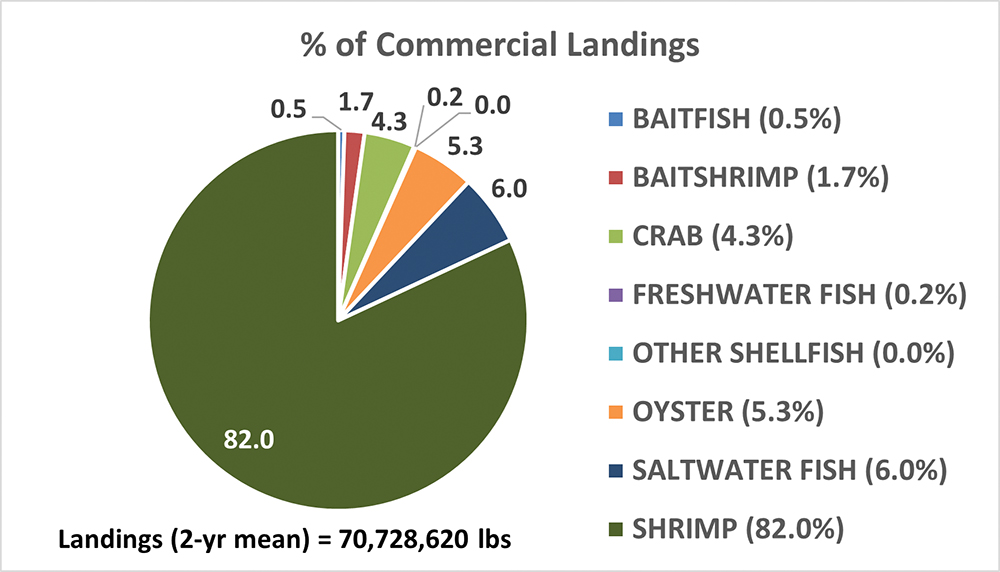Texas’ Commercial Fisheries: Data Collection and Trends

Figure 1: Percentage of commercial landings by species category based on the mean of landings from 2021-2022
Texas’ bountiful bays, estuaries, and Gulf of Mexico waters have rich and diverse ecosystems that have long supported economically important commercial (and recreational) fisheries. Between having local seafood conveniently available at markets and restaurants to being able to stop by the bait shop to pick up an edge for that epic fishing trip, Texas’ commercial fisheries benefit many resident Texans and Texas visitors. With Texas’ aquatic resources being so critical in supporting both commercial and recreational fishing, it is necessary to collect data that can be used to properly manage the state’s fisheries and ensure their continued, long-term health.
Texas has a long history of collecting data for commercial fisheries. Reports of commercial landings of marine species from Texas bays and the adjacent Gulf of Mexico have been collected from seafood dealers since 1887. These early reports were collected sporadically, but as consumer demand for oysters, shrimp, crabs and fish continued to increase, so did the need for consistent reporting. Understanding the number of pounds harvested (landings) and the value of these aquatic products is needed to effectively manage fisheries. In 1936, Texas Parks and Wildlife Department (TPWD) initiated mandatory reporting by seafood dealers of their annual fisheries landings and value on the Texas Coast. From 1994-2006, TPWD used Monthly Aquatic Products Reports (MAPRs) to better track the aquatic products landings by seafood dealers. TPWD also began requiring bait dealers to report their purchases from fishermen. These were monthly paper reports that collected information on the species caught, quantity, area fished and “ex-vessel” value (dockside price).
In 2006, TPWD replaced MAPRs with the Trip Ticket Program. A trip ticket collects detailed harvest information for each individual trip made by a commercial fisherman. This was a tremendous change from the monthly summary information that the MAPRs collected. Additionally, trip tickets collect information about the commercial fisherman, like their name, license number, and vessel information. Collecting data at the trip level is a major improvement as it allows fishery managers to better quantify the catch per unit of effort (CPUE) expended by the commercial fisherman. Calculating CPUE can show trends in the health of a fishery; for example, a lower CPUE reflects a lower catch for the same or more effort, which indicates a possible issue. These trends allow regulatory decision makers to make informed decisions in protecting the fishery and the industry. The records the trip ticket program maintains can also be beneficial to the fishing industry, as records of trip tickets are typically necessary when applying for financial relief for losses incurred due to a hurricane, oil spill, or even COVID. Reporting to the trip ticket program is mandatory, and citations can be given to help with compliance. Participants are required to submit all trip tickets by the 10th day of the month following the month when the trip was completed.
Trip ticket program participants can submit either paper or electronic trip tickets; however, TPWD is working towards reporting using only a web-based reporting app, as it greatly decreases data processing time and has built in data checks that help with accuracy and data standardization. The web-based version is also more versatile as it makes it possible for a seafood or bait dealer to use a phone or a tablet if a desktop or laptop is not available.
While there are around a hundred different species landed commercially each year, most of the landings are made up of a handful of species. Specifically, shrimp make up 82% of the average (2021-2022) annual landings of 71 million pounds, whereas saltwater fish, oysters, and crabs combined are only 16% of the total landings (Figure 1). The combined monetary value of these recent annual landings is over 204 million dollars.
Red Drum and Spotted Seatrout, some of the most recreationally sought after fish in Texas, can no longer be caught commercially because they are designated as game fish. However, there are a few other important recreational species that are also landed by commercial fishermen: Black Drum and Red Snapper. These two species account for over 90% of Texas’ commercial saltwater fish landings. Black Drum and Red Snapper commercial landings are greater than estimated recreational landings; however, Black Drum have shown a significant decrease in commercial landings from their peak of over 4 million pounds in the late-90s, while recreational drum catches have significantly increased over that same period. Both commercial and recreational red snapper landings have significantly increased since the 80s.
Southern Flounder are another important recreational fish, but only account for 0.5% of commercial saltwater fish landings. Flounder were a major commercial fishery during the mid-80s, once exceeding recreational catches. However, a significant decrease in commercial (and recreational) landings has occurred for several reasons, one of which being a decrease in daily bag limits and licensed finfish fishermen.
The importance of the bait fishing industry should not be underestimated as it serves millions of Texas’ recreational fishermen. Bait shrimp, mullet, and croaker are the most popular bait, with shrimp landings being 10x greater than croaker or mullet. All bait species have tended to increase in landings over the years and their price per pound continues to increase as well. Interestingly, since 2018, croaker landings have decreased, while mullet have increased.
While historic trends for some fisheries have seen some declines, observing trends in landings from trip ticket data over the last 10 years have shown increases. This indicates stability in our Texas commercial (and recreational) fisheries.


